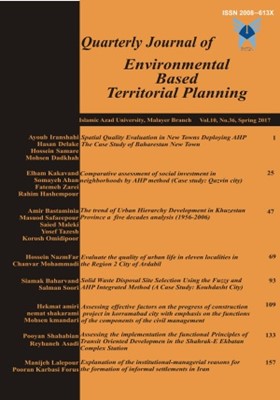Evaluate the quality of urban life in eleven localities in the Region 2 City of Ardabil
Subject Areas :
Hossein NazmFar
1
,
Chanvar Mohammadi
2
1 - PhD, Associate Professor, Geography and Urban Planning, Mohaghegh Ardebily University, Iran
2 - MScs, Geography and Urban Planning, Mohaghegh Ardebily University, Iran
Received: 2015-04-17
Accepted : 2016-03-15
Published : 2017-05-22
Keywords:
VIKOR,
quality of life,
the city of Ardabil,
Region two localities,
the Shannon entropy,
Abstract :
The quality of life measures to the understanding and satisfaction with the needs of the citizens and is related to aspects of their lives. The objective and subjective criteria is investigated in two dimensions in this research. The purpose of this study is the evaluation of the quality of life in Neighborhoods and Regions of the city of Ardabil. This study is supposed to be objective and analytical in its nature. Data was collected in the field (questionnaire) and through the analysis of the documents (library). Statistical population of the Regions and the neighborhoods of the city of Ardabil is about eleven localities( areas) Using Cochran formula the required sample was estimated and 385 subjects were randomly selected. Indicators have been weighted using Shannon entropy Vikor model and they were evaluated to determine the quality of life in the communities. Research results show there are huge differences between localities in terms of quality of life. As the results, it was understood that the neighborhood four, with zero points, is the most prosperous and is in the first place. Neighborhood three is relatively prosperous in the second position with points 0/451 and six neighborhoods with 0/575,, ten 0/578, eight with 0/586, one with 0/602, two 0/612, nine by 0/623, five And seven with 0/772 Ranking the third to tenth And half prosperous Eleven district with 1 point in last place and have been deprived, respectively.
References:
اونق، ناز، م.،1384. بررسی رابطه بین سرمایههای اجتماعی و کیفیت زندگی. رساله کارشناسی ارشد، دانشکده علوم اجتماعی تهران، 34.
جاجرمی،ک.،کلته، ا. 1385. سنجش وضعیت شاخصهای کیفیت زندگی در شهر از نظر شهروندان مطالعه موردی گنبد قابوس. مجله جغرافیا و توسعه، سال چهارم، شماره 8، دانشگاه سیستان و بلوچستان، دانشکده ادبیات و علوم انسانی. 18-5.
حبیبپور،ک.، صفری، ر.1391. راهنمای جامع کاربرد SPSS در تحقیقات پیمایشی (تحلیل داده های کمی).چاپ پنجم، شرکت تعاونی آموزش و پژوهشی راهبرد پیمایش.
خواجه شاهکوشی، ع.، حسینی، ح.، طوسی، ر.،1393.ارزیابی و سنجش کیفیت زندگی تأثیر آن بر مشارکت شهروندان در امور شهری مورد شناسی :مینودشت. جغرافیا و آمایش – منطقه، شماره 10، 86-73.
دهداری،ط.،1381.بررسی تأثیر آموزش بر کیفیت زندگی بیماران با عمل جراحی قلب باز.پایاننامه کارشناسی ارشد دانشکده علوم پزشکی دانشگاه تربیت مدرس. 40.
رضوانی، م.،منصوریان،ح.،1387.سنجش کیفیت: بررسی مفاهیم، شاخصها، مدلها وارائهی مدل پیشنهادی برای نواحی روستایی.فصلنامه روستا وتوسعه، سال 11، شماره 3، 26-1.
سلیمانی، م.، منصوریان، ح.، براتی،ز.،1392. سنجش کیفیت زندگی در محله های در حال گذر شهری (مورد مطالعه: محله دروازه شمیران از منطقه 12 شهر تهران). جغرافیا (فصلنامه بینالمللی انجمن جغرافیا ایران)، دوره جدید، سال یازدهم، شماره 38، 75-51.
عباسی قوزلو، ح.، ارزیابی کیفیت زندگی شهری منطقه 8 تبریز. پایاننامه کارشناسی ارشد جغرافیا و برنامهریزی شهری، دانشگاه محقق اردبیلی، اردبیل، 4-7-60.
عظیمی،آ.،1389.ابعاد و شاخصهای کیفیت زندگی شهری. ماهنامه اطلاع رسانی آموزشی و پژوهشی، شماره 55. 8-4.
علی اکبری، ا.، امینی، م.،1389. کیفیت زندگی شهری ایران (1385-1365). فصل نامه علمی پژوهشی رفاه اجتماعی، سال دهم، شماره 36، 148-121.
غیاثوند، ا.،1388. تأثیر سرمایه اجتماعی بر کیفیت زندگی ساکنان محلات. فصل نامه مهندس مشاور، شماره 45. 27-22.
لطفی، ص.، فرج ملایی، ا.، منوچهری، ا.، عظیمی، آ.،1390. تحلیل کیفیت زندگی شهری با استفاده از روش آنتروپی و تکنیک saw، مطالعه موردی بافت شهری میاندوآب. فصلنامه آمایش جغرافیایی فضا، سال اول، شماره 1.صص 86-69.
کرد زنگنه، ج. 1385.بررسی کیفیت زندگی مرتبط با سالمندان و عوامل مؤثر بر آن. پایاننامهی کارشناسی ارشد، دانشکده علوم اجتماعی تهران. 20.
محمدی، ج. زنگنه، م.، عبدلی،ا. 1389.سنجش شاخصهای کیفیت زندگی از نظر شهروندان شهر مشهد. فصلنامه مطالعات شهری، سال دوم، شماره سوم، 117-97.
محمودی،ع.،1390.تحلیل تطبیقی شاخصهای کیفیت زندگی در محلات فرسوده درون شهری (نمونه موردی: محلههای خانیآباد و شوش منطقه 12 شهر تهران. پایاننامه کارشناسی ارشد رشته شهرسازی) گرایش برنامهریزی شهری و منطقهای، دانشگاه تربت مدرس، دانشکده هنر و معماری، 2-61-62-84.
مرکز آمار ایران، سرشماری عمومی نفوس مسکن سالهای 1335-1390
نوابخش، ن.،1391.کیفیت زندگی شهری و برخی عوامل اجتماعی موثر بر آن در شهر کرمانشاه. فصلنامه مطالعات شهری، سال دوم، شماره سوم. 82-65.
Beatriz,C.,2012.Effects of different modes of local public services delivery on quality of life in Spain, Journal of Cleaner Production,37; 68-81
Fili,A., Elmas,E.,2011.Improvement of Quality of Life for an AnatolianTraditional Settlement: Konya-Sille Case,Pocedia-Socedia and Behavioral Sciencees 35,420-430.
Janse, A.J.,2004."Quality of life: patients and doctors don't always agree: a meta-analysis". Journal of Clinical Epidemiology. Vol. 57, No. 7.
21-Lee,J., 2008. Subjective Quality of Life Measurement in Taipei, Building and Environment, Vol. 43, PP. 1205-1215 .
Mohammad,M.,2012. Objective Analysis of Variation in the Regional Quality of Life in Malaysia and its Policy Implications, Social and Behavioral Sciences, 101;454 – 464.
McGregor,A.,1998."A poverty of agency: resource management amongst poor people in Bangladesh", In: European Network of Bangladesh Studies Workshop. Bath: University of Bath.
Moller, V., Schlemmer, L.,1982. "Quality of life in South Africa: towards an instrument for the assessment of quality of life and basic needs". Social Indicators Research, No. 12.
Pal, A. K.,Kumar,U.,2005. "Quality of life concept for the evaluation of societal development of rural community in west Bangal, India", Rural Development. No. 2.
Stover, M.E., Leven, C.L.,1992.Methodological Issues in the Determination of the Qualityز of L ife in Urban Area. Urban Studies, Vol. 29, No. 5, PP. 737- 754.
Thumboo,J.,, Kok-Yong Fong,D.,2003.Quality of life in an urban Asian population:the impact of ethnicity and socio-economic status, SocialScience & Medicine, 56, pp:1761–1772.
UNPF (United Nations Population Fund),2007. State of World Population 2007.
_||_


